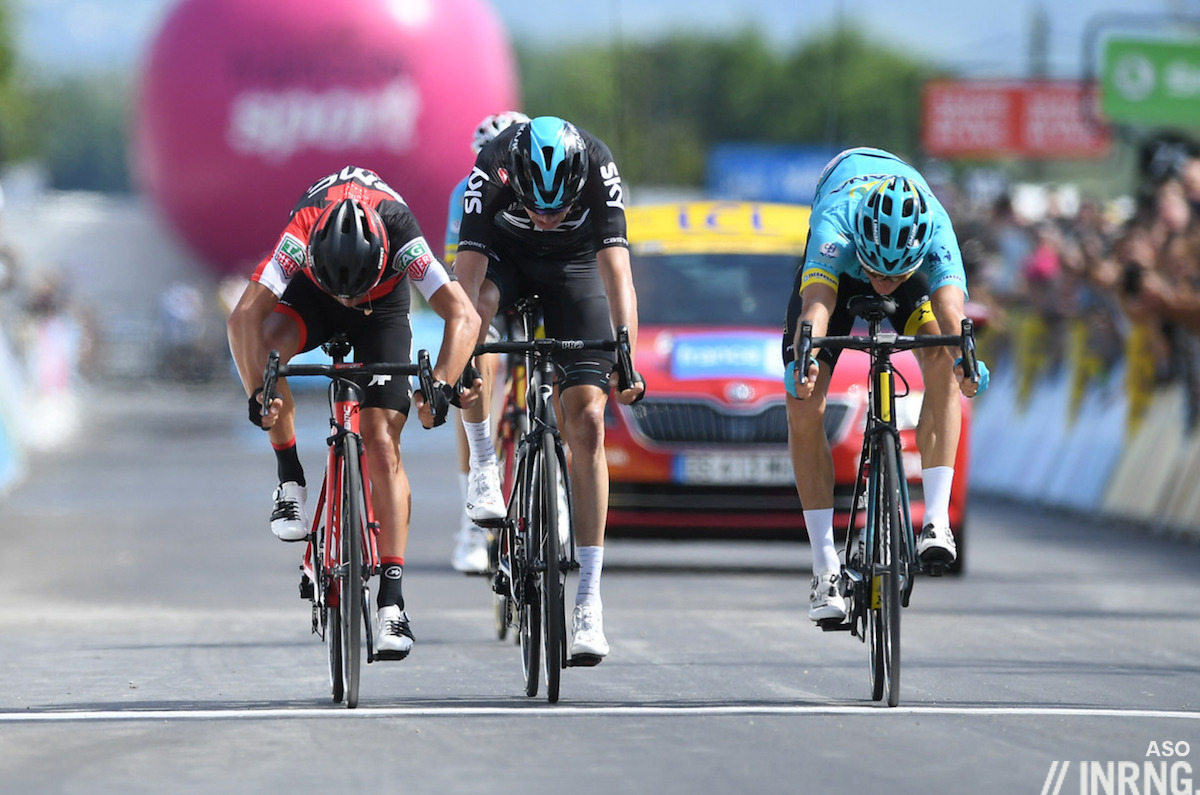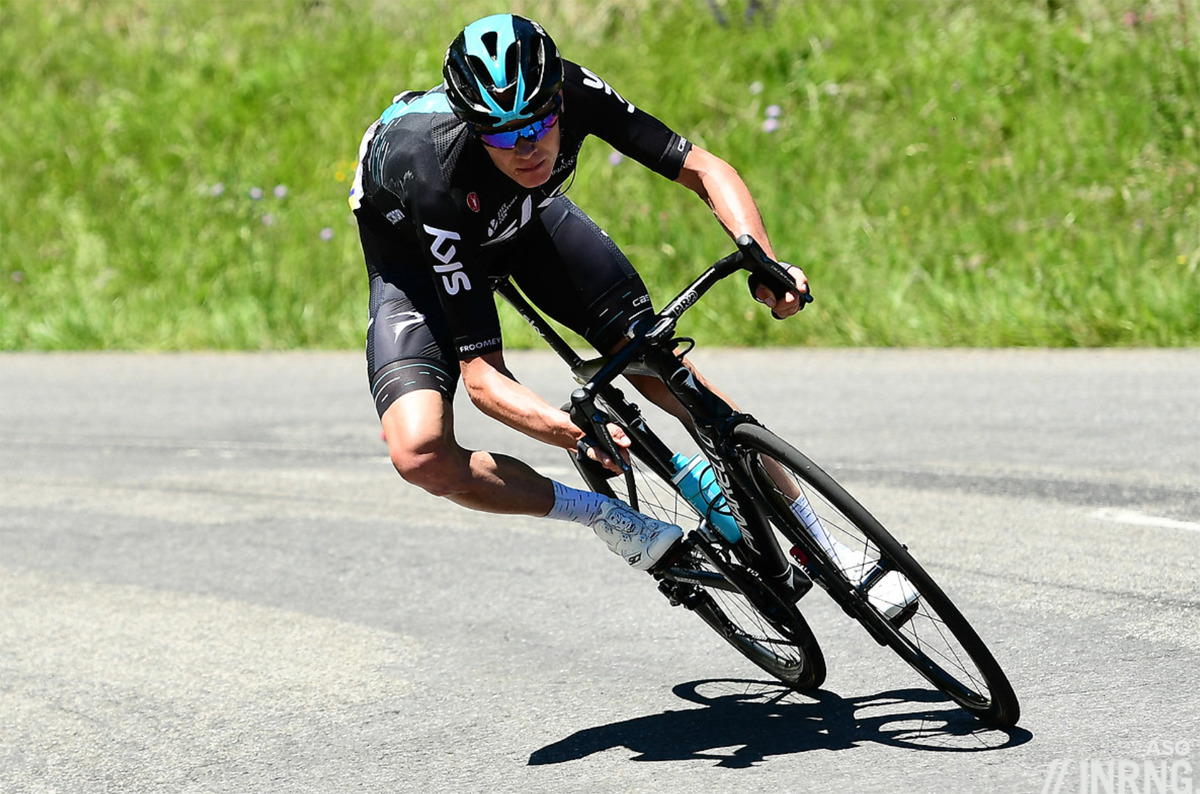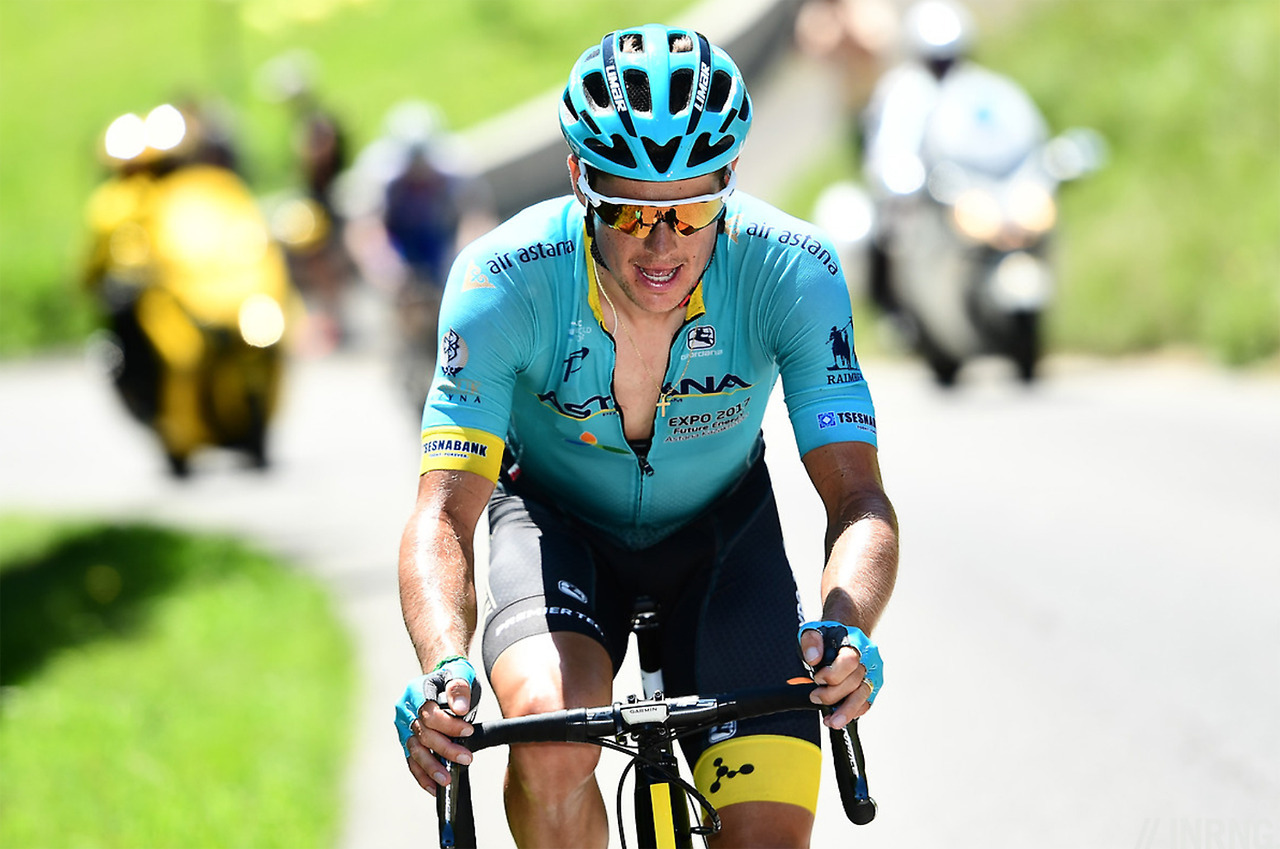The last of the five picks is the final stage of the Critérium du Dauphiné, a 115km sprint across several Alpine passes. These short stages are like dessert as they’re best served after other courses have been consumed and this came after a week of good racing and set things up nicely for the Tour de France… possibly too well.
This is a pre-Tour race and a prime attraction is seeing the form of the overall contenders for July. The week supplied this but plenty more starting with Thomas de Gendt winning the opening stage, powering away from the breakaway on the final climb of the finishing circuit around Saint Étienne. The cherubic Koen Bouwman also won from a breakaway on a day promised to the sprinters, satisfaction agai in seeing a move stick. Arnaud Démare won a sprint and the points jersey but none of the sprinters looked convincing, notably Alexander Kristoff while Bryan Coquard’s season was ending following his contractual divorce from Direct Énergie. Sunweb’s Phil Bauhaus won a sprint stage.

The 23.5km time trial saw the overall contenders come out to play and Richie Porte won ahead of Tony Martin and Alejandro Valverde with Chris Froome 37 seconds back or 1.5 seconds per kilometre which mattered in the moment and beyond as question marks began to appear. A curiously timed media “leak” that Froome was mulling an offer from BMC Racing stirred things further.

Froome reassured the following day on the anticipated stage over the Mont du Chat. Jacob Fuglsang won, claiming a 10 second time bonus which matters with hindsight but at the time was merely a fringe benefit from his first ever win in a World Tour race. But note Oliver Naesen was pulled back from the breakaway by Ag2r but he may well have won the stage, an impressive ride. The Mont du Chat lived up to its promise, the severe slopes scattering the peloton over the side of the mountain. Fabio Aru was first over the top via a series of attacks and accelerations; team mate Fuglsang was more steady. While Aru danced away the Dane eased up to meet Porte and Froome at the top of the climb. The four regrouped on the descent in part thanks to Froome’s ride-it-like-you-stole-it descending.
The final stage was a 115km stage with 4,000m of climbing including a “new” summit finish. The stage promised fireworks and duly began like a blaze in a pyrotechnics warehouse. There were wave after wave on uncontrolled attacks with the big names starting early, including Froome but many others. The result was that Richie Porte was quickly isolated. The only downside was that this was not live on TV until halfway up the Col de la Colombière.

Astana tried the old 1-2. First they fired Fabio Aru up the road on the Col de la Colombière with Alejandro Valverde for company, two clear threats to Richie Porte’s yellow jersey. Sure enough at the top of the pass they were seconds away from becoming the virtual race leaders. Should Porte have let them go? Ideally not but to contain them would be to see Romain Bardet or Chris Froome counter attack and so on. Indeed with hindsight Porte’s caution paid off because Aru and Valverde were reeled in so those two didn’t threaten him. But others did and by then Porte had lost contact with almost all his rivals on the descent of the Colombière and had to work hard to chase. Froome was again descending with that feral style.

Often we think of only the mountains and their descents but the ensuing flat section along the Arve valley was crucial, Porte having to chase by himself except for a turn or two from Sam Oomen while the likes of Fuglsang and Froome enjoyed a Sedan chair ride to the foot of the next climb with Michał Kwiatkowski – who had caught and passed Porte on the descent – instrumental in towing the Froome-Fuglsang group. They started the steep ascent to the Plateau de Solaison fresh and quickly brought back Aru and Valverde while Porte had been toiling for some time. Fresh Fuglsang was able to respond when Dan Martin attacked halfway up the climb, the Dane went with him and later on dropped him to go solo. Porte chased all the way up the climb and barely concerd time, aided by his single-minded task rather than the tactics of a group but impressive nonetheless because he’d had to toil on the valley approach road. But after Fuglsang the clocked was ticking and Porte crossed the ten seconds too late to save his yellow jersey.
With hindsight: Richie Porte narrowly lost the race on the descent of the Colombière. He’s not a bad descender but after winning the time trial and climbing with the best this is his relative weak point and this would cost him in the Tour. What could have been we’ll never know but based on his Dauphiné form the podium looked a reasonable extrapolation.
Just as travelling can be better than arriving, anticipation can be more enjoyable than reality and the Dauphiné’s position on the calendar makes the pilot episode for the Tour de France in July. Arguably this is its raison d’être, we tune in to follow the overall contenders for the Tour de France. So Froome’s struggles in June hinted at the possibility of a more open Tour, a change of script for once… although in time we got the same show again. It seems Froome was ill in June, something that for obvious reasons only came out later.
Fuglsang didn’t get much momentum from his win. If anything his win seems tangential, incidental given the way the Tour overshadows this race and he couldn’t follow through. He could have played an interesting 1-2 win Aru in the Tour but was off the pace on the first Planche des Belles Filles and would leave the race after cracking his wrist before reaching the Pyrenees. Nothing to show? On the contrary, he renewed a contract at Astana following his Dauphiné win and presumably cashed in on a high.
Why the highlight? The final stage of the Dauphiné has been a regular highlight – think Talansky trumping Froome and Contador in 2014 – and this delivered again with the overall result in play right until the final seconds. More so as Froome was challenging and risk-taking and others took their chances too.

Other highlights? The problem with lists is you exclude. There were so many more enjoyable moments such as the suspense of Milan-Sanremo, a slow burner but incendiary from the Poggio onwards. The Italian championships were lively with a selective circuit that included the kind of climb many Belgium and Dutch riders must dream of in order to wear their national championships jersey; French too because even if the country has some big climbs they seem to keep awarding the championships to Dullsville. The Route du Sud visiting Gavarnie was a treat and revealed Rigo Urán was in condition. La Course on the Izoard was spectacular and live from start to finish. The Omloop Het Nieuwsblad was good; ditto the Three Days of De Panne. Lombardia was a fine finish to the season in Europe. And we don’t have to pick races or moments, the likes of Julian Alaphilippe amd Tim Wellens seem refreshing for their fearless attacks which eventually pay off. Share your highlights below…



Great choice. I watched the final stage live on TV in Australia, and was completely enthralled. Watching Porte trying to claw back time on Fuglsang on the final climb, catching and then leaving Froome behind, only to fall just short for the final GC… exciting stuff.
It was an excellent race and revealed the Mont du Chat as a double-headed hydra with its ascent and descent the stuff of titans.
I enjoyed the Daily Diaz pieces of IR’s Vuelta coverage, especially the one that told us of the Treaty of the Pyrenees. If I had ever known that Spain once controlled Flanders then I had long forgotten but it eventually rang a childhood bell – does anyone remember the dubbed French tv series ‘The Flashing Blade’ that was on our screens on Saturday mornings?
But it sealed a realisation that there is probably not a metre of Europe’s landscape that hasn’t been fought over at some point in its history.
But great added value for a cycling blog.
https://www.youtube.com/watch?v=z-ZEDNkZ2L4
Happy days.
The Flashing Blade – proper kids TV, highlight numer 6 for me 🙂
Omar Fraile’s win on Stage 11 of the Giro. Race was blown to shreds. He worked his tail off in the breakaway and still managed to claim his first win in a Grand Tour. Rollercoaster in the last 8k. Thought they were doomed when Tiralongo went across. Terrific efforts from Costa, Fraile, and Rolland to thwart the rest of their escapees.
A good day’s racing and the only pity was the GC riders behind didn’t shake things up too much.
The Monuments were great again, with the possible exception of LBL, and Amstel Gold was much improved thanks to the new route.
In the GTs I really enjoyed the Tour stage wins by Calmejane and Uran which were back to back days. Calmejane cramping up and Uran stuck in his 53×11. It was interesting to see Roglic take a mountain stage too…
Uran and Roglic: yes I said yes.
La Vuelta had several highlights, the greatest was the Angliru stage and of course Contador´s victory
Amstwl is NOT a monument.
I think that’s aimed at my comment? I do know that but obviously didn’t structure my sentence well enough. What I meant was that in previous years I found the race pretty dull – way behind classics like Omloop, E3, San Sebastián etc. I even preferred races like Le Samyn, GP Wallonia and Tro-Bro Leon. But this year’s Amstel was much better in my opinion.
What this race told me was ‘Don’t follow Porte on a descent – at best, you’ll lose time’. He’s significantly weaker than most other GC contenders and should go and practise, as Froome evidently has.
My predictions are almost invariably wrong, but – sadly for Dan Martin – this one wasn’t: Porte seemed to be descending beyond his limits and I was watching through my fingers.
I don’t disagree with the five selections; but Contador’s farewell vuelta was a three-week greatest hits tour deseriving a mention.
El Pistolero’s relentless attacks—anticipated or ambushes—were a showpiece of entertainment I think we will never see equalled.
The fairytale ending at Angliru made me weep…
He was entertaining but got the nod in the Paris-Nice highlight and this touched on his whole season of attacks. The Vuelta was a bit different with his setback (illness) on the road to Andorra which gave him room to attack.
You’re right.
I seemingly forgot the ending paragraphs of a post i’d read a week ago.
– My short-term memory does not honour me…
How lucky was Contador that his illness in Andorra lost him 3 minutes but no more and then disappeared as soon as it had come? It kept the will-he-won’t-he suspense going for three weeks and set up the fairy tale beautifully.
A very nice final stage, although part of the spectacle is granted by the fact that most of the big names don’t see winning here as a priority, while at the same time most of those who really want to win this… aren’t top names.
It looks like that – probably because of the double goal of Tour and Vuelta – even Sky and Froome duly went back to what was the traditional approach to this race (and the one still preferred by most top riders): if you want to win when it really matters, it’s better if you race here pretty much short of your best form.
In that sense, even if the action as such was longer and better in Dauphiné, the technical value of a stage like Mont Caro or the final one in Barcelona during Vuelta a Catalunya is notably higher. Add to that the Reus stage were Froome, who still tackled Valverde by some 20″, was blown by long range action, or the “polemica” in the TTT and you’ll have a *very* good race… which isn’t even being named here.
Ditto for Tirreno-Adriatico, where GC competition was spoiled by Thomas’ woes and Quintana too clear a superiority (but you had Dumoulin, Pinot, Urán, Dennis, Thomas, Roglic et al. all going hard for GC), yet, if one looks at the value of single stages, Thomas in Pomarance and both Sagan’s victories, especially the one in Fermo, were impressive, with the latter being huge – with lots of action, too.
None of these even desrved a mention in “Other highlights” although they arguably were more interesting than Dauphiné itself – as a *real* race, I mean.
Again: I’ll acknowledge that Dauphiné’s couple of mountain stages were a great show; I’d just say that it’s open to debate if one prefers more spectacle or higher competition – I myself couldn’t say and might even end up preferring Dauphiné in an edition like this (unlike others we had in recent years, say 2015).
Yet, I can’t avoid finding it surprising that those other races didn’t even deserve a mention, especially given what sort of modest “other highlights” are instead named.
I guess that we must accept it as a characteristic trait of our guest, riding the line between sokurovian Francofonia and Francomania 😛
And the personal touch is also an added value of this blog, although it may cost some perspective.
All good picks too. I think I sometimes look for stages that deliver action and change to the GC, so Porte getting worked over on the Colombière beats Caro or Sagan’s wins in Tirreno, where we saw good racing but with Sagan especially the result seemed inevitable. The final stage of the Giro in Sardegna in the crosswinds was another I thought too.
There’s been some good sprinting this year too, it’s one area that doesn’t get much TV coverage because it is so fast and few broadcasters do much analysis.
As I said, in terms of action I’d agree that Dauphiné had more. The point is finding a balance between action and competition, as in Dauphiné you often have the impression that the riders have something else in their minds (well, the Tour), which makes them racing in a *peculiar* way – entertaining, no doubt, but not what they’d do in a race they want hard to win. But, all in all, it was a good choice.
Just a couple of small points: firstly, Mont Caro was pretty much decisive in terms of GC, Valverde was 45″ away from the top due to the TTT mess, a difference that’s not easy to subvert in such a short race. Soler, Contador and A. Yates were 6th to 8th and they’d going to be the podium contender, with an immediate effect the following day when long range attacks eliminated the then-2nd placed Froome. But, yes, the action was limited to the last 20 minutes, when the first attacks started, and Contador’s key move came at 4 kms to the line. Good, especially for today’s standards, but not long range.
Conversely, the Fermo stage had enough action through the day but little final effects on GC, indeed, even if only a selected group of 13 riders came in at less than 30″. But they were all the strongest GC riders (bar A. Yates). Dennis, Roglic and Thomas carved their place in the top 5 and Urán and Mollema made it to the top ten, but that’s no radical change – a confirmation, rather. What I’d dispute is Sagan being a prime pick for such a stage, not to speak of an “inevitable” result. Not with his current cobble weight (cfr. Tour de Pologne). He himself declared that until the very last moment of the race he wasn’t believing he could fight for such a Liège-like stage, all the daily top-ten was occupied by GC riders, not one-day racers.
I’d totally second your comment about the Sardegna stage and the sprints: we had good sprints and some new exciting names.
Final stage of Paris Nice – What a fantastic spectacle my legs ached just watching
i bet Valverde was expecting at least . mention 😀
i bet Valverde was expecting at least a
mention 😀